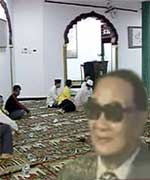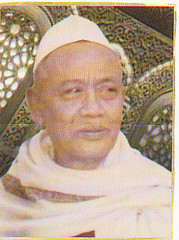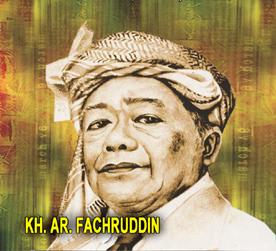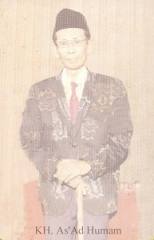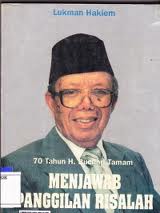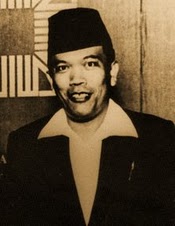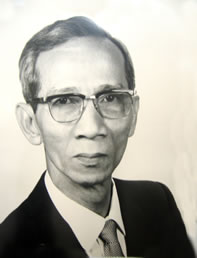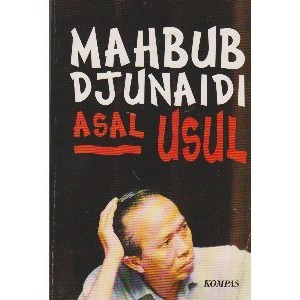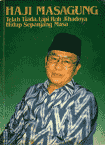ABDULKARIM OEY TJENG HIEN
ABDULKARIM Oey Tjeng Hien, one of the most prominent Muslims of Chinese descent, died on 15 october 1988. Born in 1905 in Padang, West Sumatra, Oey became a Muslim in 1931 in Bengkulu. He was an active member of the Muhammadiyah and became very close to Sukarno (later the first Indonesian president) during his period of exile in Bengkulu. From 1957 to 1960, Oey was a member of parliament.
He held several important functions in the business world, but was better known for his social and religious acitivities.
ACHMAD SJAICHU
K.H. ACHMAD Sjaikhu was an NU personality and a member of the Honorary Council of the World Mosque Council was born on 29 June 1921 in Surabaya, East Java, and studied at Pesantren Al Hidayah of Lasem, Central Java (1937-1941). For 30 years he was known as a respected NU politician. He was the chairman of the DPR Gotong Royong (Mutual Cooperation of the House of Representatives) (1966-1970) and an NU faction member of the DPR (1971-1978).
At that time, he was most famous as instigator of the dissolution of the PKI and the role he played in the process of the resignation of President Soekarno and the installation of Lt. Gen. Soeharto as the new president in 1966.
Joining the forces with Dr. Idham Khalid, he was successful in withdrawing NU membership from the Masyumi party and creating the NU itself as a party. He was also known as one of the figures behind the success of the NU in the first general election in 1955.
In 1964, he was entrusted with the office of Secretary General of the Islamic Conference of Asia Africa and two years later he chaired it.
Syaichu, who was an inveterate peripatetic preacher, established the Ittihadul Muballighin, a forum for Muslim preachers, in 1970 and initiated the creation of the Rabithatul Ma’ahidil Islam iyah (RMI). (GA, 14 Jan.; HT, 5, 6 Jan.; JP, 5 Jan.; KO, 6, 7 Jan.; PE, RE, 5 Jan. 1995)
On 4 January 1995, K.H. Achmad Syaichu died of complications following an inflammation of the pancreas compounded by lung cancer at the public hospital Cipto Mangunkusumo in Jakarta where he had been receiving medical treatment since 24 November 1994. He was buried in the grounds of his pesantren, Pesantren Al Ham idiyah in Sawangan, Bogor, West Java.
ACHMAD SIDDIQ
K.H. ACHMAD Siddiq, Ro’is Aam (General Chairman) of the Syuriah (Legislative Body) of the Nahdlatul Ulama died on 23 January 1991 in Surabaya, East Java. Achmad Siddiq was known for his influence on the decision of the Nu to accept the Pancasila ideology as its own ideological basis and the Pancasila state as the final organizational form of the Indonesian people, and not just an intermediatery stage. In everyday life he was the leader of the Pesantren Ashshiddiqiyah in Jember, East Java.
In 1984, he was elected to the office of the Ro’is Aam of the NU, a position extended at the NU Congress of 1989. He also held the public offices of member of the Dewan Pertimbangan Agung (Supreme Consultative Council, DPA) and of the Dewan Pendidikan Nasional (National Education Counci, DPN)l. His function in the NU is temporarily being filled by K.H. Ali Yafie, Vice-Ro’is Aam. a new Ro’is Aam will be nominated at a plenary meeting of the central leadership of the NU, to be held in the first month after next Ramadhan.
The Persatuan Mahasiswa Islam Indonesia (Indonesian Association of Muslim Students, PMII), a student-wing of the NU, has proposed to the government that K.H. Achmad Siddiq be nominated as a national hero.
ALI MA’SHUM
K.H. ALI Ma’shum, leader of Pesantren al-Munawwir in Krapyak, Yogyakarta, which had just hosted the 28th NU Congress, passed away at the age of 74 in the Sardjito Hospital, Yogyakarta on 7 December 1989.
Ali Ma’shum was born in 1915 as son of KH Ma’shum, one of the founders of the Nahdlatul Ulama. Since 1949 he had led Pesantren Al-Munawwir. In 1955, he was elected a member of the House of Representatives for the NU political party. From 1982 to 1984 he had been Ro’is Aam of the Syuriah of the NU.
He was known as an expert in the Qur’an interpretation and was fluent in Arabic.
During seventies, he taught at IAIN Sunan Kalijaga in Yogyakarta.
AMIR HAMZAH WIRYOSUKARTO

A collection of KH Mas Mansur’s articles which were collected by Amir Hamzah Wiryosukarto and published in Surabaya, 1968..
DRS AMIR Hamzah Wirjosukarto was a prominent figure in the Pelajar Islam Indonesia (PII) and Muhammadiyah. He passed away on 18 February 1995.
After completing his study at the Faculty of Educa¬tion of the UGM in Yogyakarta, he was assigned to teach at its sister faculty at the University of Brawidjaya, Malang, East Java. Under the Old Order, he was dismissed by President Soekarno when he defended the HMI. Under President Soeharto he was rehabilitated and assigned to teach at the IKIP of Malang. He was also a lecturer at the Muhammadiyah University of Malang. Hamzah was the Chairman of the PII (1954-1956), an outspoken member of the DPR for the PPP fraction (1977-1982), and the chairman of the Lembaga Hikmah Muhammadiyah of the East Java branch.
His thesis at the UGM was published by the Muhammadiyah Executive Board under the title Pembaharuan Pendidikan dan Pengajaran Muhammadiyah (The Renewal of Educa-tion and Teaching of Muhammadiyah). His other publications include Sejarah Pendidikan National (History of National Education), Rangkaian Mutu Manikam dari Kyai Hadji Mas Mansur (Collection of Scattered Articles of K.H. Mas Mansur), Wawasan Politik Seorang Patriot Dr Soekiman Wirjosandjojo (Political Perspective of a Patriot, Dr Soekiman Wirjosandjojo), Sekitar Piagam Jakarta (About the Jakarta Chapter), and Ordonansi Sekolah Liar (Illegal School Ordinance). (MD, April 1995)
A.R. FACHRUDDIN
K.H. ABDUL Rozaq Fachruddin was former chairman of the Muhammadiyah (1968-1990). Fachruddin was born in Olang Purwanggan, Pakualaman, Yogyakarta on 14 February 1916. His father, K.H. Fachruddin, was active in the Muhammadiyah.
After having studied Islam with his father, he continued his studies with several Muslim scholars in Kulonprogo including K.H. Abdullah Rosad and K.H. Abu Amar.
During the struggle for Independence he joined the Hizbullah militia. He was the Head of the Kulonprogo Office of Religious Affairs, the Head of the Yogyakarta and Semarang Offices of the Religious Information. He was also a member of the DPA (Supreme Supervisory Council) of what] He then studied at a madrasah of the Muhammadiyah and the Madrasah Muballighin (Muslim preachers’ school) Muhammadiyah in Yogyakarta. Having completed his course, he was sent to teach at various places in South Sumatra. He returned to Yogyakarta and taught at the Madrasah Darul Ulum Muhammadiyah. Later he lectured on Islam at several universities in Semarang, Central Java, including the Universitas Diponegoro and the Universitas Sultan Agung.
In 1962 he became vice-chairman of the Muhammadiyah. From 1968 to 1990 he was chairman of the organization. He was known as a modest person whose sermons were delivered. He often preached on television at the state-owned television TVRI and on radio at the state-owned radio RRI of Yogyakarta. The local newspaper, Kedaulatan Rakyat, published his answers to questions pertaining to Islam and social problems.
He died at the age of 79, on 17 March 1995 of complications following vertigo, a heart abscess, and leukaemia in the Islamic Hospital of Jakarta. President Soeharto, who had just returned from Bosnia, paid his last respects at the hospital and ordered a special plane, a Hercules of the Indonesian Air Force to transport his body to Yogyakarta, where it was buried at the public cemetery of Karangkajen, Kotagede, Yogyakarta. (GA, 25 March; PM, 21-31 March; PE, RE, 18 March 1995)
AS’AD HUMAM
K.H. AS’AD Humam was the discoverer of the ‘lqra’ method. He passed away on 2 February 1996 in Yogyakarta after having medical treatment for some time in the Muhammadiyah Hospital there. He was 62 years old. He is survived by his wife and six children.
The lqra method is a new practical and fast method of learning the Koran. He was appreciated by the Department of Religious Affairs for his services in eliminating Koranic illiteracy. The method, since 1988, has spread not only throughout Indonesia, but also to such foreign countries as Malaysia, Brunei, Australia, Saudi Arabia and the USA. (PE, 3 Feb.; Re, 23 Feb.; PM, 15-29 Feb.; UM, 4 March 1995)
AS’AD SYAMSULARIFIN
K.H. RADEN As’ad Syamsul Arifin, leader od Pesantren Salafiyah Syafi’iyah in Sukorejo, near Situbondo, East Java, and a charismatic figure widely respected both in Muslim and government circles, passed away on 4 August 1990 at the age of 93.
As’ad was born in Mecca, Saudi Arabia. His father, K.H. Raden Syamsul Arifin, alias K.H. Ibrahim bin K.H. Ruhan, was a scion of the nobility of Pamekasan on the island of Madura, which were descended from Sunan Ampel and Sunan Kudus, two of the legendary pioneers of Javanese islamisation.
After his father had founded a pesantren in Sukorejo in 1908, As’ad was sent back to Mecca to study under several prominent Islamic teachers. He returned from Mecca in 1914, but only started to teach at his father’s pesantren ten years later.
As’ad modernized the educational system by introducing the madrasah system, which meant the introduction of some ‘secular’ and modern subjetcs in addition to the traditional religious ones.
He had some military experiences as well: during the war of indepedence in 1945, he led the Barisan Sabilillah (“For the Cause of God [from Arabic fi sabil allah] front) militia.
From 1957-1959, he was a member of the Dewan Konstituante (Parliament) for the Nahdlatul Ulama (NU) political party. But, when he was offered the office of minister religious affairs by President Sukarno, he preferred to concentrate on his pesantren instead.
When about 1983 the NU experienced a period of conflict about the political line it should adopt, he was one of the members to suggest it secede from PPP and revert to the Khittah of 1926, which implies that the NU remains a social and religious organization, wihtout direct involvement in political life.
Because of his doubts about K.H. Abdurrahman Wahid, the head of NU’s Tanfidziyah elected in 1989, he decided to distance himself from the NU: he refused to pray – and work – together with the new leadership.
In the last message to the NU, As’ad urged the organization to abide by the teachings if the ‘salaf’ (forefathers, i.e. the first generations of the Muslim community) and the ‘khittah’ of 1926. K.H. Achmad Siddiq, Ro’is Aam of the syuriah of the NU, suggested that K.H. Raden As’ad Syamsul Arifin be awarded the title of “national hero.”
BEY ARIFIN
K.H. BEY Arifin was a noted Muslim preacher and former chairman of the East Java branch of the MUI. He passed away in Surabaya on 30 April 1995 at the age of 78 years. He is survived by a wife, twelve children and 19 grandchildren.
Bey Arifin was born in the village of Parak Leweh, Tilatang, Bukittinggi, West Sumatra, on 9 Zulhijjah 1336H/29 September 1917). After completing Volckshool and Vervolgschool, he continued his study to Islamic schools from primary to Padang Islamic Colege in 1938.
Then, he taught in various Islamic schools in Sumatra, Java and South Kalimantan. Besides that, he was known as a lecturer and muballigh. He also was an Imam at the East Java’s Kodam (Military Regional Command) VIII Brawijaya till his retirement in 1970.
Arifin wrote articles for newspapers and magazines since 1940. And since 1960, he actively wrote various books, among others Rangkaian Cerita dalam Al-Quran (Series of Stories in Al-Qur’an), Mengenal Tuhan (Recognizing God), Hidup Sesudah Mati (Life After Death), Bey Arifin kontra Yusuf Roni (Bey Arifin contra Jusuf Roni) and Samudra Al-Fatihah (The Sea of Al Fatihah [The Opening Chapter of the Koran]). Besides, he translated Muhammad Yusuf Al-Kandahlawi’s Kehidupan Para Sahabat Rasulullah SAW (Life of Prophet Muhammad (PBUH)’s Companions) and Abul Hasan Ali Al-Hassani An-Nadwi‘s Sejarah Hidup Rasulullah SAW (Biography of Prophet Muhammad PBUH) (HT, I May 1995)
BUCHARI TAMAM
H. BUCHARI Tamam was a Muslim activist and the Secretary General of the Yayasan Dewan Dakwah Islamiyah Indonesia (Yayaan DDII, Foundation of the Indonesian Islamic Propagation Council. He passed away on 31 December 1994 in Jakarta at the age of 72 after a long illness.
Tamam was born in Agam, West Sumatra on 4 July 1922. From an early age, he had been active in various Islamic movements. He was an activist of the Persatuan Murid Diniyah School (PMDS – School Association of Religious Students). He was once interrogated by the Politieke Inlichtingen Dienst (PID) for his involvement in a political rally which attacked the Dutch colonial power, under the Japanese occupation, he was the Chairman of the Himpunan Pemuda Islam Indonesia (Indonesian Association of Muslim Youth). When Soekarno called him to dissolve the organization, Tamam froze its activities.
He then taught at the Taman Raya School and gave lectures at a mosque in Balingka. He refused to cooperate with the Japanese occupying force. After the Proclamation of Independence he was chosen to lead the Central Sumatra branch of the Gerakan Pemuda Islam Indonesia (GPII – Indonesian Muslim Youth Movement).
In 1957, he initiated the Congress of All-Sumatran ‘Ulanta. in Bukittinggi, West Sumatra, and the National Congress of All-Indonesian ‘Ulama’ in Palembang, South Sumatra. In the latter congress. he was chosen Secretary General of the Majelis Permusvawaratan Ulama Indonesia (MPUI – Consultative Council of Indonesian ‘Ulama).
From 1958 to 1961, he was involved in the rebellion of the Pemerintah Revolusioner Republik Indonesia (PRRI – Revolutionary Government of the Republic of Indonesia). After being granted a public amnesty by the government, he created the Yayasan Kesejahteraan (Welfare Foundation) which coordinated vocational training in many fields such as silkworm raising, poultry farming, agrarian activities in Tasikmalaya, Sukabumi, Bogor, and Jakarta. After the Communists accused his foundation of being a camouflage from behind which former activists of the PRRI could relaunch their rebellion, Tamam became involved in urban armed opposition. At that time he maintained contact with M. Natsir, a leader of the Masyumi party who was in political quarantine in Malang, East Java.
In 1967, joining ten former members of the defunct Masyumi party, he created both the DDII at the Al-Munawarah Mosque in Tanah Abang, Jakarta, and the Yayasan Al Ghurobaa’ which runs a campus and a mosque. Up to his death, he was the Rector of the Islamic Institute of Al Ghurobaa’ in Jakarta. (MD, Feb.; PE, 2 Jan. 1995)
DJARNAWI HADIKUSUMO
DJARNAWI Hadikusumo was a figure of Muhammadiyah and Muslim politician. He was born in the Kauman district of Yogyakarta, on 4 July 1920. He was a son of Ki Bagus Hadikusumo, another leading figure of the Muhammadiyah, who participated in the framing of the Piagam Jakarta (Jakarta Charter – a document attempting to define the relationship between the newly independent state and Islam) in 1945. During his life, Djarnawi Hadikusumo was active in several fields, including politics, religious life, sports, and the arts. After finishing the Madrasah Mu’allimin (Islamic Teacher Training Schools) of the Muhammadiyah in Yogyakarta, he became a teacher and then a school principal in Medan, North Sumatra.
(1938-1942). During the Japanese occupation, he was active in the Barisan Pemuda Indonesia (Indonesian Youth Guard), a youth militia. He also joined the Police Force for five years (1945-1950). Hadikusumo set up a marching band and led the Tapak Suci, a martial arts group within the Muhammadiyah (1963-1964). In his political life, he was the chairman of the Partai Muslimin Indonesia and a legislator (1969-1971). He was pressured to pass the leadership of the party on to H.J. Naro in 1971. The party then fused into the PPP.
He was also an active writer. Among his books are Pendidikan dan Kemajuan (Education and Progress), Korban Perasaan (Victim of Senti¬ment), Pertentangan (Contradiction), Marsudi, Si Anak Tin dari Desa Waleri (Marsudi, the Stepson from the Village of Waleri), Kristologi (Christology) and Aliran Pembaharuan Islam: Dari Jamaluddin Al-Afghani sampai KRA Dahlan (The Current of Islamic Renewal; from Jamaluddin al-Afghffni to K.H.A. Dahlan). He was also involved in journalism and once headed the Suara Muhammadiyah (Voice of the Muhammadiyah) monthly magazine and the daily Masa Kini, both affiliated to the Muhammadiyah. (RE, 27 Oct.; KO, PE, 28 Oct. 1993)
HAMAM DJA’FAR
K.H. HAMAM Dja’far, leader of Pesantren Pabelan of Magelang, near the Borobudur temple, Central Java, passed away of heart attack on 17 March 1993. He was born in 1937 in the village of Mungkid, Pabelan.
Hamam Dja’far studied in Pesantren gontor from 1954 to 1965. Afterwards he led Pesantren Pabelan. During his leadership, he was known for his reforms in the pesantren system and his views on education of democratic santris.
He also distinguished himself in the design of his pesantren which eliminated fences and thus integrated it into the surrounding villages. For this reason, Pesantren Pabelan received the “Aga Khan Award for Architecture” in 1980 and on another occasion the “Kalpataru” Award from President Soeharto.
Hamam Dja’far was also a deputy chairman of the MUI (1985-1990) and a member of the Research and Development Agency of the Central java branch of the GUPPI.
Pesantren Pabelan was established in 1800 by Kiai Muhammad ali. The word ‘Pabelan’ originally comes from the word “pembela” (defender). This name was chosen because the place became a vasis for santris who supported the struggle of Prince diponegoro against the ducth colonial regime in the early 19th century.
HARSONO TJOKROAMINOTO
HARSONO Tjokroaminoto passed away on 22 April 1992 after spending two months for treatment for a stroke in the Gatot Subroto Military Hospital, Jakarta, and died of bone marrow disorder in his knee.
Harsono was the third son of Haji Oemar Said Tjokroaminoto, the founder of Syarikat Islam, the first Islamic political organization in Indonesia. He was born on 24 April 1913 in Madiun, East Java.
He had been involved in the struggle for Indonesia’s independence from an early date. In 1937, he was a member and, then, secretary of the Majlisul Islam A’la Indonesia (MIAI), a federation of Islamic organizations, as well as editor of the Suara MIAI magazine and a member if the Gabungan Politik Indonesia (GAPI, Indonesian Political combination), a federation of political organizations.
He was founder of the Gerakan Angkatan Baru (New Generation Movement) and Gerakan Pemuda Islam Indonesia (GPII, Indonesian Movement of Muslim Youth) in 1945.
He was a junior minister of defence in the cabinets of Sjahrir II, Natsir and Burhanuddin harahap. he also was Minister for Administrative Reforms from 1968 to 1971 and a member of the Dewan Pertimbangan Agung (DPA) from 1975 to 1983.
His last official positions were those of a member of the Penasihat Presiden tentang Pelaksanaan Pedoman Penghayatan dan Pengamalan Pancasila (P7, Presidential Advisers on the Implementation of the Guidelines for the Socialization and Realisation of Pancasila), and chairman of the Perintis Indonesia (Indonesian Pioneers).
His body was buried with full military honours at the Hero’s Cemetery in Kalibata, South Jakarta.
HASYIM Asy’ari was born Muhammad Hasyim in Gedang, Jombang Regency on February 14, 1871. His parents were Asy’ari and Halimah. His grandfather, Kiai Usman was the founder of Pesantren Gedang and his great grandfather was the founder of Pesantren Tambakberas. He was the third son of ten siblings.
Hasyim Asy’ari’s ancestry can be traced to Sultan Joko Tingkir (Hadiwijaya) of Pajang, and further, to Brawijaya VI (Girindrawardhana), the last king of Majapahit.
At the age of twenty, he married Khadijah, daughter of Pesantren Siwalan Panji leader. He married seven times and all of his wives were daughters of ulama. Four of his wives were Khadijah, Nafisah, Nafiqah and Masrurah. One of his son, Wahid Hasyim was one of Jakarta Charter formulator and later became Minister of Religious Affair, while his grandson Abdurrahman Wahid became President of Indonesia.
One year later, they went to Mecca. After seven months, his wife was dead and also his son, Abdullah two months later.
In 1899, he founded Pesantren Tebuireng, which later became the largest pesantren in Java in early 20th century. The pesantren was also became the center for the reform of traditional Islamic teaching.
On January 31, 1926 he and several traditional Islamic leaders founded Nahdatul Ulama (Awakening of Ulama). In Japanese occupation era, he was arrested, several months later he was released and became Head of Religious Affairs.
During the Indonesia’s independece war, he released ‘Resolusi Jihad’ (Jihad Resolution), a fatwa (religious edict) that driving the spirit of Indonesian people, especially in Surabaya, to struggle defending their country from the Dutch colonialist and the Allied Forces.
He died on July 25, 1947 cause of hypertension after hearing news that Dutch troops was winning a battle in Malang. His body was buried in Tebu Ireng, Jombang.
IMAM ZARKASYI
K.H.IMAM Zarkasyi was born in Gontor, Ponorogo, East Java, on March 21, 1910, and died on March 30, 1985. His father is Santausa Annam Bashari who came from a Java elite family and is third generation from the leader of Gontor and fifth generation from Prince Hadiraja Adipati Anom, son of Sultan Kasepuhan Cirebon. His mother hailed from Suriadiningrat, famous in the chronicle of Mangkubumen and Penambangan (Mangkunegaran).
After the death of his mother in 1920, Imam Zarkasyi started to study in Pesantren Joresan , and he learned some book like Ta’lim al-Muta’alim, al-Sullam, Safinah al-Naja and al-Taqrib. Three years later, he continued his general education in Ongko Loro School. Main lesson in this Pesantren is tauhid, beside memorize Al-Qur’an , Barzanji, and speech. After that he continued his study in Pesantren Jamsaren, Solo, and at the same time he studied in Mambaul Ulum, still in the equal town he studied in Arabiyah Adabiyah School led by K.H.Al-Hasyimi, until 1930.
During his studies, he was very interested in Arabic language. He continued his study in Kweekschool in Padang Panjang, West Sumatra until 1935. After finishing his education his teacher, Mahmud Yunus asked him to be director in this school but Imam Zarkasyi just fulfilleed this request one year, because chose to participate in developing Gontor, then he returned to Gontor.
In 1936, Imam Zarkasyi introduced new program in Gontor with the title ‘Kulliyatul Mu’allimin al-Islamiyah’ (KMI). The program was influenced by his experience during studying in Sumatra Thawalib School, Normal Islam School.
Beside active in education, he was also involved in social and political activities. For instance, in 1943 he became the head of Madiun Residence’s Religious Office Residence. During Japanese occupation period. he was active to establish and became lecturer in Hizbullah, Cibarusa, West Java. After independent day Imam Zarkasyi active to set up the Ministry of Religious Affairs. In 1946 he became the head of Section of Religious Education Department from Committee of Education Research. For eight years (1948-1955), he became the chairman of Persatuan Guru Islam Indonesia (Association of Indonesian Islamic Teachers, PGII). He also led to design the Religious Education (1951-1953), the Chairman of the Committee for Religious Education (1953), the head of Consultative Body of Religious Education and Teaching (Majelis Pertimbangan Pendidikan dan Pengajaran Agama, MP3A), member of national planning committee in 1959. In international relations, Imam Zarkasyi was a member of Indonesian delegation to Uni Soviet in 1962, after ten year he represented Indonesia in Mu’tamar Majma al-Buhuts al-Islamiyah in Cairo, Egypt. He also once became a member of the MUI.
Beside these activities in education, social, and politics, Imam Zarkasyi was also productive in writing. He wrote some scientific works and up to now still is used in Modern Pesantren Darussalam Gontor Ponorogo and the other Pesantren. His labor like Senjata Penganjur dan Pemimpin Islam, Pedoman Pendidikan Modern, Kursus Agama Islam. After that he wrote Ushuluddin, Pelajar Fiqh I dan II, Bimbingan Keimanan, Pelajaran Bahasa Arab I dan II, Kamus Bahasa Arab, and the other book. He also wrote some technique instruction for student and teacher in Gontor, for some problem that related with education in Pesantren, include method of teaching.
IMRON ROSYADI
KH IMRON Rosyadi SH, a prominent figure of the Nahdlatul Ulama who was well known as a diplomat and politician, passed away in Bandung, West Java, on 13 March 1993. His body was buried in a family graveyard in Cicalangka, near Bandung.
Rosyadi was born on 12 January 1916 in Indramayu, West Java. He completed the HIS in Indramayu and the MULO in Bandung and Cirebon, West Java. Although he received a Dutch school education, he was eager to deepen his understanding of Islam. For this reason, he later studied in Pesantren jamsaren and Madrasah Robithoh alawiyah in Solo, Central Java. At his own expenses, he continued studies at the Madrasah Saulatiyah of Mecca, Saudi Arabia, then he moved on to study at a senior high school in Baghdad, Iraq. Afterwards he studies at the International Law College of Iraq.
He worked as a diplomat at the Indonesian Embassies in Saudi Arabia, Iraq and Switzerland. Besides this, he also become a lecturer at the Akademi Hukum Militer (Military Law Academy, 1953-1963), the Universitas Nasional of Jakarta, and in 1977 was nominated rector of the Sunan Giri University of Surabaya, East Java.
His political career started as chairman of the Gerakan Pemuda Ansor (1954-1963), he held leading became member of the House of Representatives (1957-1959) and of the Liga Demokrasi, which was criticalof Sukarno’s “Guided Democracy” (1960-1961). From 1962 to 1966, he was jailed by Sukarno’s regime. He then became active as a member of the PPP from 1973 till 1992. When a conflict between the NU and the PPP arose, he did not agree with the campaign waged by the NU leadership at that time to withdraw its members from the party. He remained active in the PPP.
He was knon for his assertiveness during hearings and political deliberations. He did not hesitate to voice opinions critical of government officials and was respected by both colleagues and the press. One of his last duties was to act as President Soeharto’s envoy to several Middle Eastern countries to invite their heads of states to attend the 10th summit conference of the Non-Aligned Movement Countries in Jakarta in September 1992.
JOESOEF SOU’YB

Book cover ‘Sejarah Daulat Khulafaur Rasyidin” by Prof. Joesoef Sou’yb, published by Bulan Bintang, Jakarta.
PROF. H.M. JOESOEF Sou’yb, a well-known Muslim intellectual and historian, died in Medan, North Sumatra, on 7 January 1993. He was born in Bayur, Maninjau, West sumatra, on 14 July 1916.
After finished his studies at the Sumatra Thawalib school of Padang Panjang, he continued at the Pendidikan tarbiyah Islamiyah (Islamic education) of Candung, near Bukittinggi (1931-1935), and the Faculty of Law at the Universitas Islam Sumatra Utara (Islamic University of North Sumatra, UISU) of Medan, North Sumatra (1951-1954).
He started his career as a journalist and headed a number of press periodicals in Medan. He also wrote columns for several newspapers and magazines. Besides this he was known as a lecturer in journalism and philosophy at several universities in Medan such as the IAIN, UISU and the Muhammadiyah University of North Sumatra.
He wrote some 50 books on Islam, history, philosophy, and Christianity.
LAFRAN PANE
PROF LAFRAN Pane, who was one the founders of the Himpunan Mahasiswa Islam (Indonesian Association of Islamic Students, HMI) in 1947 and Professor of Public Institutions at the State Teacher Training’s Institute (IKIP) and the Universitas Islam Indonesia (Islamic University of Indonesia) in yogyakarta, passed away on 24 January 1991 in Yogyakarta.
Lafran Pane was born on 12 April 1923 in Sipirok, Padang Sidempuan, North Sumatra. He was a younger brother of Sanusi and Armijn Pane, two prominent Indonesian men of letters.
He graduated from Gadjah Mada University, Yogyakarta, in 1953. In 1988, he was nominated a member of the Dewan Pertimbangan Agung (Supreme Consultative Body, DPA).
Prof. Lafran was also known as an expert in religious philosophy.
MAHBUB DJUNAIDI
MAHBUB Djunaidi was a well-known politician, journalist and man of letters of Nahdhatul Ulama circle. He passed away on 1 October 1995 at his home in Bandung, West Java. He was 62 years old. He is survived by his wife, their two sons, three daughters and three grandchildren.
Born on 27 July 1933 in Jakarta, Djunaidi came to prominence in the 1950s as the leader of a number of Muslim organizations. He was the first leader of the PMII – Indonesian Muslim Students Association (1960-1967), and was Chairman of the Nandlatul Ulama (1984-1989). He was also active in the Students Association of the NU, the Youth Movement of the NU and the Association of Muslim Students. A member of the House of Representatives from 1960 to 1970, Djunaidi also served as both Advisory Council member and a Deputy Chief of the United Development Party (PPP). He later left the PPP.
Djunaidi served as Chief Editor of the daily Duta Masyarakat of the NU, was Editor-in-Chief of the Antara news agency from 1962 until 1965 and chaired the Indonesian Journalists Association (PWI) from 1965 to 1970.
Since his time as a student, he had been active in writing. In 1974, he wrote a novel entitled Dari Hari ke Hari, published by the Pustaka Jaya Publisher (1975). He also translated several books such as the works of Michael Hart, Jules Verne, Art Buchwald, George Orwell and Hassanain Heikal. (HT, JP, KO, RE, 2 Oct. 1995)
MALIK AHMAD
MALIK Ahmad is a Muslim figure and an activist of Muhammadiyah Islamic organisation. He was the head of the Social Service Office of the province of Central Sumatra and member of the Konstituante (1956-1959), was known as an Muhammadiyah activist in West Sumatra, working in conjunction with A.R. Sutan Mansyur and Hamka. He was also director of the Kulliyatul Muballighin Muhammadiyah (Muhammadiyah Preachers’ College) in Padang Panjang, West Sumatra.
After leading the Jakarta branch of the Muhammadiyah (1965-1968) he was appointed a deputy-chairman of the Muhammadiyah Central Board (1968-1985). Ever since then he had been an advisor of the organization. During his life-time, he was active in the fields of the propagation of Islam and education. He also wrote several books, such as Tafsir Sinar, a Qur’an commentary.
Malik Ahmad died in Jakarta on 19 October at the age of 81 (PE, 20 Oct. 1993)
MASAGUNG
HAJI Masagung, a successful Muslim businessman and book publisher, died on 24 September 1990 in Jakarta. Masagung, an Indonesian of Chinese descent, was born in Jakarta on 8 September 1927 and was given the name Tjio Wie Tay.
He started his business as a cigarette pedlar. In 1953, with the former Indonesian vice-president M. Hatta and the literary critic H.B. Jassin, he founded PT Gunung Agung, a firm specialized in the book trade and stationary.
It developed into a large enterprise.
He embraced Islam in 1975.
In 1985, he relinquished all his business to his sons, to concentrate on his Islamic bookshop “Walisongo”, an Islamic Information Centre and other activities in the field of Islamic information and culture. It’s located on Jalan Kwitang, between his two bookshops.
MOHAMMAD NATSIR
MOHAMMAD Natsir, a leading Muslim figure and former prime minister, passed away, On 6 February 1993. His death followed from complications from a heart disease, pneumonia, and bronchitis. He died at the Cipto Mangunkusumo Hospital where he had been in intensive care for three months. He was buried the next day at the public cemetery of Karet, Central Jakarta, beside the tomb of his wife, Putri Nurnahar.
Mohammad Natsir, who bore the traditional Minangkabau “Datuk Sinaro Panjang”, was born in Alahan Panjang, Solok Regency, West Sumatra, on 17 July 1908. After completing the Adabiyah (Arts) section of the HIS (Hollandsch-Inlandsche School – Duthc-Native School), and madrasah as well as the MULO (Meer Uitgebreid Lager Onderweij – Dutch tyoe of extended primary education) in Padang (1916-1927), West Sumatra, he continued his studies at the AMS – Algemene Middlebare School (Dutch-type General Secondary School) in Bandung, West java. In this city, he also studied Islamic religion with A Hassan, one of the founders of the Persatuan Islam (Persis) and was involved in political life through some Islamic-oriented organizations such as the Jong islamieten Bond (JIB), Boedi Oetomo, Syarikat Islam (SI), and the Muhammadiyah. With Hassan, he directed the magazine Pembela Islam (Defender of Islam).
His political career continued when he became an executive member of the Komite Nasional Indonesia Pusat (KNIP – Central Indonesian National Committee) (1945-1946), minister of information in three successive cabinets (1946-1949), chairman of the Masyumi Party (1949-1958), prime minister (1950-1951), and member of the rebellious Pemerintah Revolusioner Republik Indonesia (PRRI, Revolutionary Government of the Indonesian Republic) (1958-1960). For this last mentioned activity, he was jailed by the Soekarno regime in Batu, near Malang, East Java (1960-1962) and in Jakarta (1962-1966).
His monumental merit to Indonesian political history was when his proposal, which was known as “the integral motion of Natsir”, was accepted by the Parliament in 1950. The proposal led to re-creation of the unified state of Republik Indonesia (RI) and the end of the one-year old Republik Indonesia Serikat (RIS, United States of Indonesia). The RIS consisted of 17-Dutch-created puppet states. It was on these grounds that President Sukarno appointed him prime minister.
In the same year, he represented the Indonesian government at an international Islamic meeting in Karachi, Pakistan. On this occasion, he spoke on Pancasila, the first speech made by an Indonesian leader abroad on the Indonesian state ideology. In 1982, however, he once more spoke on Pancasila to the House of Representatives. This time together with a number of leaders from various Islamic organizations, he asked the government to purify the ideology because it had deviated from the original spirit.
He was also known for his polemics on religious and poltical matters with Sukarno, who represented the (“secular”) Nationalist group, when the latter figure in exile in Ende, Flores, East Nusa Tenggara, in the 1930s.
Likewise famous was his address of 12 November 1957 before the Dewan Konstituante entitled Pilih Antara Dua Jalan: Agama atau Tanpa Agama (Choose Between Two Ways: Religion or without Religion). Natsir pronounced his address at the moment that the Konstituate had to decide on the fundamental ideology of the state. However, before the Konstituante could take a decision, it was dispersed by President Sukarno using the argument that the quorum had not been reached. This was what Natsir called a coup d’etat by Sukarno.
Natsir also criticized Soeharto’s presidency, saying that he limited the activities of the Indonesian mass organizations and political parties. In 1980, he was one of the signatories to a critical petition to the Indonesian government. Because of the number of signatories, their statement became known as the “Petisi 50”. As a consequence of this move the signatories underwent what they called “the loss of civil rights”. They were hampered in their business and in traveling abroad. Natsir was several times unable to attend international Islamic meetings.
However, a month before the Indonesian election in June 1992, he called on Muslims to support the Muslim-backed PPP. According to him, his call was aimed at defending the multi-party system in Indonesian political life. He even urged the MPR to limit the maximum span of office for an Indonesian president to two terms. The MPR should dare to discuss this matter before they elected the new president, he added.
Since 1967, Natsir had been concentrating on Islamic propagation by establishing the Yayasan Dewan Dakwah Islamiyah Indonesia (Yayaan DDII, Foundation of the Indonesian Islamic Propagation Council). Afterwards, he was appointed vice president of the Karachi-based Mu’tamar al-Alam al-Islami (World Muslim League, 1969), member of Majlis al-a’la al-Islami lil-Masajid (the World Mosques council, 1972), member of the Founding Board of the International Islamic Charitable Foundation, Kuwait (1985), as well as member of the Founding Board of the Oxfors Centre for Islamic Studies, Great Britain, and member of the Council of Trustees of the International Islamic university of Islamabad, Pakistan (1986). In 1980, he received the “Faisal Award” for his dedication to Islam from the King Faisal Foundation of the Kingdom of Saudi Arabia.
Besides politics and religion, he was also active in the education sector. He was director of Islamic education of Bandung for ten years (1932-1942) and afterwards head of the Office for Education in the same city (1942-1945).
He also wrote a number of books, among them Kapita Selecta, Marilah Salat! (Let’s Pray!) and Islam dan Kristen di Indonesia (Islam and Christianty in Indonesia). His address of 1957, Pilih antara Dua Jalan, was translated into Arabic by Geys Ammar (the present chairman of Al-Irsyad) and was published in the Syrian Muslim magazine Al-Muslimun (managed by Sa’id Ramadan, a figure of al-Ikhwan al-Muslimun organization and son-in-law of Hasan al-Banna, founder of the organization. In 1970, this Arabic translation was published as a book under the title Ikhtaru ahad al-sabilayn: al-din aw al-ladiniyah. Accordng to Geys Ammar, this book has become a reference work in the Middle East.
In the middle of February 1993, a group of students from the Universitas Islam Bandung (Unisba), West Java, issued an appeal to the government to name M. Natsir a national hero. Later they were followed by a number of Muslim students in Yogyakarta, united in the Generasi Muda Muslim Yogyakarta (GMYY, Muslim Young Generation of Yogyakarta).
Finally, their efforts were successful after fifteen years later. On 6 November 2008, the Indonesian government bestowed Natsir a national hero.
MUHAMMAD ALHABSYI
KH SAYID MUHAMMAD Alhabsji was born on 15 April 1903 in Kwitang, Jakarta. He studied for six years in the Hadramaut (South Yemen) and then in Mecca and Egypt, each for one year.
Returning from his studies abroad, he led the madrasah which had been created by his father, Habib Ali Alhabsji. This madrasah was closed during the Japanese occupation. But he continued the Majelis Taklim Kwitang (the majlis talim, i.e. council for [religious] education, of Kwitang) and developed it into an Indonesian Islamic Centre. He was a member of the Dewan Pertimbangan Agung (DPA – Supreme Advisory Council) for the period of 1975-1980, a deputy chairman of the MITI and a member of the board of patrons of Golkar.
However, he had abandoned his political activities since 1977.
On 11 December 1993, Alhabsji, known as Habib Kwitang, passed away from diabetes and old age in the Gatot Subroto Hospital of Central Jakarta. His body was buried the next day in the grounds of the Mosque of Kwitang, beside his father’s tomb. (RE, 12, 13 Dec.; JP, KO, PE, 13 Dec. 1993)
MUHAMMAD ARSYAL AL-BANJARI
MUHAMMAD Arsyad al-Banjari was one of the most eminent scholars from Borneo. His full name is Syeikh Muhammad Arsyad ibn Abdullah ibn Abdur Rahman al¬Banjari ibn Sayid Abu Bakar ibn Sayid Abdullah al-Aidrus ibn Sayid Abu Bakar as-SaKran ibn Sayid AbdurRahman al-Sagaf ibn Sayid
– Muhammad Mauwla al-Dawilah al-Aydrus, and his lineage can be traced back to Sayidina All ibn Abi – Thalib and Sayidatina Fatimah, daughter of Prophet Muhammad (peace be upon him).
He was born on 15 Safar 1122H/17 March 1710 in the village of Lok Gabang, Martapura, Banjarmasin, South Kalimantan (Borneo), Indonesia. He passed away on 6 Syawal 122714/13 October 1812 at 105. He received thorough education at the royal palace of the Sultanate Banjarmasin up to the age of 30. Then he studied in Mekah and from various scholars originated from the Malay world such as Syeikh Abdur Rahman ibn Abdul Mubin Pauh Bok al-Fathani, Syeikh Muhammad Zain ibn Faqih Jaialuddin Aceh and Syeikh Muhammad ‘Aqib bin Hasanuddin al-Falimbani. After spending 30 years in Mekah and 5 years in Madinah, he returned to his homeland to spread Islam.
His influenced spread throughout the Malay world as almost all Muslim scholars in the region were acquinted with his writings at the very least Sabil al-Muhtadin. On his return to Banjarmasin, he devoted himself to preaching and organizing activities relating to Islamic da’wah, education, and administration. Despite his busy life, he managed to write several other books. Some of his works were Tuhfah al-Raghib in fi Bayan Haqiqat Iman al-Mu’minin wa ma Yufsiduhu Ridda al Murtaddin (1188 H/1774 M), Luqtah al-‘Ajlan fi al-Haid wa al-Istihadahwa al-Nifas (1192 11/1778), Sabil al-Muhtadin li Tafaqquh fi Amr al-Din (119511/1780 M), Risalah Qaul al-Mukhtasar (1196 H/1781 M), Kitab Bab ‘an Nikah, Bidayah al-Mubtadi’ ‘Umdah al-Awlad, Kanz al-Ma’rifah, Kitab al-Faraid, Bulugh al-Maram, Fath al-Rahman, Arkan Ta’lim al-Sibyan, Hasyiyah Fath al-Wahhab and Mushaf al-Qur’an al-Karim.
The book Sabil al-Muhtadin is his famous book. It can be found in several large libraries in Mekah, Egypt, Turkey and beirut. It is very popular in the Malay Archipelago encompassing Indonesia, Malaysa, Singapore, Thailand, Cambodia and Brunei. The topics covered in the book are shalat (prayer), zakat (alms), fasting and haj pilgrimage.
MUHAMMAD HUSEIN BA’BUD
MUHAMMAD Husein Ba’bud, a leading figure of the Indonesian ‘Alawiyyin (descendants of Ali ibn Abi Thalib and Fatimah az-Zahra, daughter of Prophet Muhammmad, PBUH), passed away in a private hospital in Singosari, near Malang, east Java, on 9 June 1993, at 90.
Ba’bud, who was known as Abu’l ‘Alawiyyin (Patriach of the Alawiyyin), was one of founders of Al-Khairiyyah (previously known as the Jam’iyat Khair) in Surabaya.
He was also a founder of Pesantren Darun Nasyiin of Lawang.
MUHAMMAD ZAMRONI
DRS MUHAMMAD Zamroni, a former Chairman of the presidium of KAMI (Kesatuan Aksi Mahasiswa Indonesia – Action Unit of Indonesian Students), who was involved in the 1960s student uprisings against the Old Order administration of the late President Soekarno. He died of a stroke in Jakarta on 5 February 1996. He is survived by his wife, three children and four grandchildren. The Muslim politician was born in Jepara, Central Java on 10 August 1935.
Zamroni studied at the Pesantren Bale Tengahan of Kudus then at the Pesantren Jamsaren, Solo, Central Java. He then continued his study at the IAIN Syarif Hidayatullah of Jakarta. He was a Secretary of the Pll (Pelajar Islam Indonesia – Indonesian Muslim Students) of Kudus and was later Secretary General of the IPNU (Ikatan Pelajar Nandlatul Ulama – Association of Nandlatul Ulama Students).
While serving as Chairman of the PMII (Indonesian Muslim Students Association), at the end of 1965, he was involved in the KAMI. He helped to establish the National Committee of Indonesian Youth in 1973. He was also a legislator of the United Development Party (PPP) from 1970 to 1987. Between 1984 and 1989, he was a Deputy Chairman of the PPP. (HT, JP, KO, PE, RE, SP, 6 Feb.; TI, 22 Feb. 1966)
SHOLEH ISKANDAR
K.H. SHOLEH Iskandar, leader of the Agricultural Pesantren Darul falah of Bogor was born on 22 June 1922, in Bogor, West Java. He died of a heart attack in Leuwiliang, near Bogor, on 22 April 1992 at the age of 70. His body was buried at the Barengkok cemetery of Leuwiliang, Bogor.
During the national liberation struggle, Sholeh Iskandar led the Hizbullah militia, which controlled the region between Jasinga and Leuwiliang. He was also an army commander of Batallion IV/VI and Battalion 0/02 whose function was to keep demarcation lines of Linggarjati and Renville, that was de facto territory of the Republic. When he was a major in 1950, he retired from the army. From 1958 to 1960, he was a vice-chairman of the Headquarters of the Legion of Veterans of the Indonesian Republic (LVRI).
He was also one of the chairmen of the Dewan Dakwah Islamiyah Indonesia (DDII), chairman of the Yayasan Pesantren Pertanian Darul Falah (Foundation of the Agricultural Pesantren Darul Falah), chairman of the Badan Kerjasama Pondok Pesantren (BKSPP) of West java, and former chairman of the Yayasan Pembina Universitas Ibnu Khaldun (Guiding Foundation of the Ibnu Khaldun University) of Bogor.
When the issue of the Porkas ( a lottery run by the government, which was later changed into the SDSB, Social Philanthropical Contribution with Prizes) was widely discussed, he published a book entitled Raf’ ltibas ‘An Qadiyyah Porkas (Lifting the Veil of the Porkas Issue).
DR SJAFRUDDIN PRAWIRANEGARA
DR SJAFRUDDIN Prawiranegara was born in Anyer Kidul, Banten, February 28, 1911. The descent of Bantenese and Minangkabau extraction. His father, R. Arsyad Prawiraatmadja was the grandson of Pagaruyung family, Sutan Alam Intan.
Educated in the Dutch-established education that was opened to the better-off indigenous population from 1903, he went on to study at Rechtshogeschool (the Dutch tertiary education institution designed originally to provide Indonesian-speaking staff for the law courts, and which eventually became the University of Indonesia), graduating in 1939.
He was an editor and former minister of finance. In 1950s, he was involved in the PRRI rebellion against the centralization of government but itwas a failure. On 25 August 1961, Sjafruddin surrendered to the army. He was imprisoned until 26 July 1966.
Upon release, Sjafruddin tended to express himself more through religion, preaching against corruption under Sukarno, and leading the Petition of 50, and opposing the concept of Pancasila as the sole guiding principle for all groups, especially religious ones, in Indonesia.
Due to this activity, Suharto banned Sjafruddin from leaving the country; Sjafruddin however continued to espouse his beliefs up until his death in 1989. He died of heart failure on 15 February 1989.
Source: Darul Aqsha, Dick van der Meij and Johan Hendrik Meuleman, Islam in Indonesia: A Survey of Events and Developments from 1988 to March 1993. Jakarta: INIS, 1995); Wikipedia; Islamia/The Brunei Times; http://wwwhusnaamalia.blogspot.com/2011/05/concept-of-education-according-imam.html; Bey Arifin, Dialog Islam & Kristen (Surabaya, 1983).

